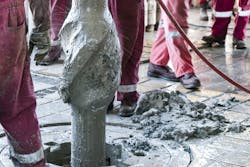PUCHHEIM, GERMANY – Drill stabilizers are an important part of the equipment used in the bottom hole assembly of a drill string. As the name suggests, their function is to mechanically stabilize the drill assembly within the borehole, enhancing the service life of the drill bit, avoiding deviation from the intended path and maintaining the quality of the hole being drilled. Although there are various types of stabilizers, they usually comprise of a main body and stabilizing blades, generally manufactured from high-grade steel, with the blades hard-faced for wear resistance.
When in use, these vital and high-value components can sustain significant wear from abrasion and therefore require re-working to rebuild the protective hard abrasive-resistant materials (FIGURE 1). Traditional methods of repairing these important components include welding and plasma transfer arc systems—however, the latest generation of fiber lasers brings a new and highly efficient dimension to metal cladding/deposition and hardening applications.
Fiber lasers, such as those used in Alpha Laser’s AL-TW, AL-FLAK and AL-ROCK laser machines, deliver the high power (450/900 W) required for laser powder deposition welding, a process that offers a wide range of benefits for applications such as the repair of drill stabilizers.
The laser makes it possible to quickly and efficiently coat even large surface areas with powder deposit welding on high-value components that require repair or reconditioning (FIGURE 2). Unlike some alternative technologies, the localized and controlled heat-affected zone produced by the laser does not impact the mechanical properties of the surrounding material. This also ensures that component distortion is avoided. In addition, the repeatability and precision of the process guarantees consistent quality on all parts.
Alpha Laser’s systems have already established a reputation for laser welding and can also be used as powder coating systems. The high levels of stability inherent within the AL-TW system enables the precision focusing required to achieve the best results. The AL-FLAK laser welding system delivers high laser power and large reach with an innovative movement mechanism and projecting laser arm that make it possible to work easily on large components, either manually or in programmed mode.
The AL-ROCK offers high laser power and large reach and is able to move the system under its own power. The articulated robot arm, coupled with its 3D scanning head, make it possible to easily work on large components, performing either deposit welding or hardening processes in three dimensions. The area to be processed can be easily programmed, using the scanner software, by simply selecting the desired area for scanning. The robot then moves the scanner automatically to the marked area over multiple tracks. The result is a real-time 3D model. The operator then simply configures the process-relevant parameters, after which the program is simulated virtually.
For more information, please visit https://alphalaser.de.
